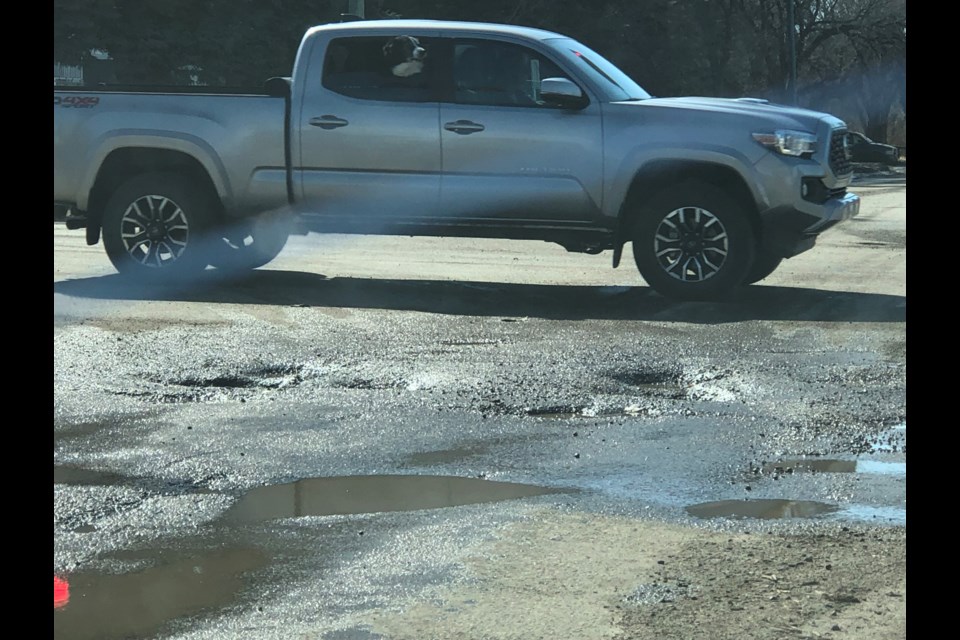MOOSE JAW - Residents know that many roads are in rough shape, but the new transportation master plan (TMP) has confirmed that fact with hard evidence and has rated each street from excellent to very poor.
The City of Moose Jaw manages 227 kilometres of roads, and three future trends that could negatively affect that infrastructure include a growing population, a growing economy and Moose Jaw’s growth as a regional business hub, the TMP says.
The TMP also says city-wide traffic volume projections are expected to increase by two per cent annually over the next decade due to new schools and infill developments. The growth also accounts for residents travelling for work, school, recreation and daily needs.
Consulting firm KGS Group included the growth of several residential and industrial developments in the 10-year traffic forecast, including West Park Village, Iron Bridge Estates, the re-development of Valley View Centre lands, Westheath and the agri-food industrial park.
Road network
KGS Group assessed every road last summer to determine the extent of the pavement’s distress and then rated each street according to its severity, the report said.
The assessment found that the overall road network has seen improvements, especially on arterial roads, where the percentage of road segments categorized as “good” doubled between 2018 and 2023. Furthermore, local and collector roads saw improvements, while the “average pavement condition” for the total network is in “fair condition.”
Bruce Belmore, with KGS Group, told council during a recent regular meeting that the consulting firm rated each road from excellent (five) to fair (three) to very poor (zero) and assigned each a corresponding colour—from green to purple to red—to accompany the rating.
“While a road in fair condition is OK, it’s also at a tipping point of not being a very good road in short order. You can see that a lot of the roads (on the map) are purple, amber and a few red ones,” he said.
Preventing deterioration
Preventative maintenance is important because road conditions can change from good to requiring replacement, Belmore pointed out. Therefore, the city should spend slightly more on its roadways budget to reduce long-term costs and decrease the need for costly reconstructions.
A chart shows three categories of costs the city should or does make for preventative road maintenance between 2024 and 2034.
The TMP suggests that the municipality should invest roughly $3.75 million annually into road renewal between 2025 and 2031 and roughly $2.25 million annually between 2032 and 2034.
Meanwhile, the city’s planned capital budget average over that 10 years is roughly $2.75 million annually, and its average projection is roughly $3.4 million annually.
“It’s an eye-opener and a slap in the face when you realize that (many of) our road conditions are orange, so they’re in poor condition,” said Mayor Clive Tolley, while a sidewalk inventory map shows that hundreds of locations have severe tripping hazards.
The city last assessed its 240 kilometres of sidewalks in 2019, the TMP said. The assessment identified more than 6,500 defect points, with roughly 25 per cent of the sidewalk network having tripping hazards.
Three areas representing 50 per cent of the sidewalk network with a high concentration of tripping hazards are:
- Ninth Avenue Northwest to Main Street from Saskatchewan Street down to Manitoba Street West
- Main Street to Eighth Avenue Northeast from Saskatchewan Street East to Fairford Street East
- Ninth Avenue Southwest to First Avenue Southeast from Home Street West down to Grandview Street West
“I … think we need a full transportation master plan, so we’re working with established priorities, and we’re working smarter and spending money smarter,” Tolley said, adding the city should also add more bike lanes for annual use.
It’s important to remember that minor resurfacing can save money and extend roads for years, which some residents don’t understand because they criticize city crews for fixing streets that appear to be in good shape, said Coun. Heather Eby.
Eby added that while the total cost to implement everything in the TMP — between $22 million and $28.4 million — “is ridiculous” and will likely never happen, it’s still good to have goals and plans.
The next regular council meeting is Monday, July 22.




